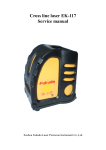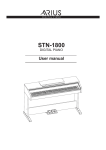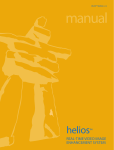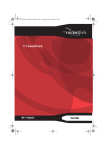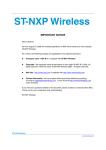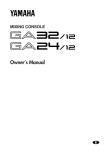Download Medeli DP10 Owner`s manual
Transcript
DIGITAL PIANO INFORMATION FOR YOUR SAFETY! THE FCC REGULATION WARNING (for USA) This equipment has been tested and found to comply with the limits for a Class B digital device, pursuant to Part 15 of the FCC Rules. These limits are designed to provide reasonable protection against harmful interference in a residential installation. This equipment generates, uses, and can radiate radio frequency energy and, if not installed and used in accordance with the instructions, may cause harmful interference to radio communications. However, there is no guarantee that interference will not occur in a particular installation. If this equipment does cause harmful interference to radio or television reception, which can be determined by turning the equipment off and on, the user is encouraged to try to correct the interference by one or more of the following measures: Reorient or relocate the receiving antenna. Increase the separation between the equipment and receiver. Connect the equipment into an outlet on a circuit different from that to which the receiver is connected. Consult the dealer or an experienced radio/TV technician for help. Unauthorized changes or modification to this system can void the user's authority to operate this equipment. CAUTION The normal function of the product may be disturbed by Strong Electro Magnetic Interference. If so, simply reset the product to resume normal operation by following the owner's manual. In case the function could not resume, please use the product in other location. PRECAUTIONS PLEASE READ CAREFULLY BEFORE PROCEEDING Please keep this manual in a safe place for future reference. Power Supply Please connect the designated AC adaptor to an AC outlet of the correct voltage. Do not connect it to an AC outlet of voltage other than that for which your instrument is intended. Unplug the AC power adaptor when not using the instrument, or during electrical storms. Connections Before connecting the instrument to other devices, turn off the power to all units. This will help prevent malfunction and / or damage to other devices. Location Do not expose the instrument to the following conditions to avoid deformation, discoloration, or more serious damage: Direct sunlight Extreme temperature or humidity Excessive dusty or dirty location Strong vibrations or shocks Close to magnetic fields Interference with other electrical devices Radios and televisions placed nearby may experience reception interference. Operate this unit at a suitable distance from radios and televisions. Cleaning Clean only with a soft, dry cloth. Do not use paint thinners, solvents, cleaning fluids, or chemical-impregnated wiping cloths. Handling Do not apply excessive force to the switches or controls. Do not let paper, metallic, or other objects into the instrument. If this happens, unplug the AC adaptor from the wall outlet. Then have the instrument inspected by qualified service personnel. Disconnect all cables before moving the instrument. 2 Contents Panel Description Front Panel...................................................................................................................................................................4 Rear Panel....................................................................................................................................................................5 Setup Part List........................................................................................................................................................................6 Setup Guide..................................................................................................................................................................6 Power Supply................................................................................................................................................................8 Connections Connecting Connecting Connecting Connecting a pair of Headphones................................................................................................................................9 an Audio Equipment..................................................................................................................................9 an MP3/CD................................................................................................................................................9 a Computer................................................................................................................................................9 Listening to the Demo song...........................................................................................................................10 Adjusting the Volume........................................................................................................................................10 Playing Voices Selecting a Voice........................................................................................................................................................10 Playing two Voice Simultaneously..............................................................................................................................11 Playing a Lower Voice................................................................................................................................................11 Touch Response.........................................................................................................................................................11 Digital Effects.......................................................................................................................................................12 Metronome............................................................................................................................................................12 Tempo......................................................................................................................................................................13 Beep Tone..............................................................................................................................................................13 Troubleshooting..................................................................................................................................................14 Specifications......................................................................................................................................................14 Appendices Voice List.................................................................................................................................................................14 MIDI Implementation List chart...................................................................................................................................15 3 Panel Description Front Panel 1 2 4 3 5 Electric Piano 1. POWER ON / OFF Turn the power ON or OFF. 2. MASTER VOLUME Adjust the master volume. 3. FUNCTION Button Hold down this button and press the special keys to realize different functions. - + 4. VOICE SELECT Key Hold down the [FUNCTION] button and press the key to select a voice. 5. TEMPO ADJUST Key Hold down the [FUNCTION] button and press the key to adjust the current tempo. 16. SUSTAIN Pedal Step on the sustain pedal, all notes played on the keyboard would have a longer sustain. 17. SOSTENUTO Pedal Step on the sostenuto pedal, the notes played before you step on would have a sustain effect. 18. SOFT Pedal Step on the soft pedal, all notes played on the keyboard would have a softer effect. 4 18 17 16 Panel Description 6 7 8 9 10 11 6. METRONOME Key Hold down the [FUNCTION] button and press the [ON/OFF] key to turn the metronome ON or OFF. Hold down the [FUNCTION] button and press the other key to select the time signature. 8. CHORUS Key Hold down the [FUNCTION] button and press the [ON/OFF] key to turn chorus effect ON or OFF. Hold down the [FUNCTION] button and press the other key to select the chorus type. 7. REVERB Key Hold down the [FUNCTION] button and press the [ON/OFF] key to turn reverb effect ON or OFF. Hold down the [FUNCTION] button and press the other key to select the reverb type. 9. TOUCH Key Hold down the [FUNCTION] button and press the key to select different touch response level. 10. DEMO Key Hold down the [FUNCTION] button and press the key to start or stop playing the demo song. 11. BEEP Key Hold down the [FUNCTION] button and press the key to turn the prompt tone ON or OFF. Rear Panel 12. USB Jack Connect to a computer. 13. AUX. OUT Jack Connect the audio equipment. 14. AUX. IN Jack Connect an external sound source, such as an MP3 or CD player. 12 13 14 15 15. DC IN Jack Connect the DC 12V power adaptor. 5 Setup This section contains information about setting up your instrument and preparing to play. Please go through this section carefully before turning the power on. Part List Before you proceeding to assemble the stand, get a Philip's screwdriver (not supplied). Make sure you have the following parts, which are supplied into package. 1 1. Piano Cabinet 2. Rear Board 3. Pedal Box 4. Left Side Board 5. Right Side Board 6. Hand Screw 7. Screw1 15mm (8 pcs) 8. Screw2 30mm(4 pcs) 9. Screw2 Cover(4 pcs) 10. Pedal Cable 10 2 5 4 3 6 Setup Guide A. Fix and well tighten the left and right side boards [4] & [5] to the pedal box [3] with Screw 2 [8]. The screw Cover(4pcs) [9] above Screw 2. 4 9 8 3 6 5 7 8 9 Setup B. Fix the rear board [2] to the left and right side boards [4] & [5] with Screw1 [7]. 7 2 5 4 3 C. Place the piano cabinet [1] on the stand, fix it with Hand Screw [6]. 1 6 2 5 4 3 D. Insert the pedal cable [10] into the proper socket of the cabinet [1]. 10 7 Setup Power Supply 1. Please make sure that POWER ON/OFF switch of the instrument is set to OFF. Then move the MASTER VOLUME knob leftwards to set the minimum volume level. 2. Connect the AC adaptor to the power supply jack. 3. Plug the AC adaptor into an AC outlet. And when turning the power OFF, simply reverse the procedure please. 4. Turn the power ON. The LED on the panel will light up. Note: When the keyboard is not in use or in the time of thunderstorm, please disconnect the power for safety purpose. 8 OFF ON Connections Connecting a pair of Headphones A standard pair of stereo headphones can be plugged in here for private practice or late-night playing. Jack1: When a pair of headphones is plugged into the Jack 1, the sound can be heard from headphones and speakers of the instrument. Jack2: When a pair of headphones is plugged into Jack 2, the internal stereo speaker system is automatically shut off . The sound can be heard from headphones. Headphone Jack 1 Headphone Jack 2 Note: Do not listen with the headphones at high volume for long periods of time. Doing so may cause hearing loss. Connecting an Audio Equipment The rear-panel AUX.OUT jack delivers the output of the instrument for connection to a keyboard amplifier, stereo sound system, a mixing console, or tape recorder. Use an audio cord to plug into the AUX.OUT jack located on the rear board then plug the other end of the cord into AUX.IN of the amplifier. Note: To avoid damaging the speakers, please ensure that the volume has been set to the minimum level before connecting the power and other devices. Connecting an MP3/CD Player Connect the audio output of an MP3/CD player or other audio source to the stereo AUX. IN jack on the rear panel. The input signal is mixed with the piano signal, allowing you to play along. Connecting a Computer Connect PC or other USB host devices that support USB audio. For devices with USB cable, you can simply connect the MIDI/USB converter to your USB connector on the device and plug the USB cable into the piano, after the driver is installed and initialization is finished, you can choose USB Audio Device in the device menu of the software to transfer midi data. Note: Do not select USB audio device in both of input and output setting together, otherwise the sound overlaps. 9 Listening to the Demo song While holding down the [FUNCTION] button, press DEMO key to start the demo song playing. Press it again to stop playing. The keyboard would be disabled when the demo song is playing. Adjusting the Volume Move the [VOLUME] knob rightwards, the volume increases. Moving it leftwards will turn the volume down. Playing Voices Selecting a Voice While holding down the [FUNCTION] button, press corresponding key in voice selecting area to select the voice you want. Note: While only one voice is selected, the dual voice and lower voice will be turned off automatically. Electric Piano Electric Piano 10 Playing Voices Playing two Voice Simultaneously You can play two voices synchronously on the keyboard by selecting a dual voice. While holding down the [FUNCTION] button, press 2 keys simultaneously in voice selecting area. Press the first key to select the upper voice, press the second key to select the dual voice. Electric Piano Notes: While dual voice is turned on, lower voice would be turned off automatically. Electric Piano Playing a Lower Voice While holding down the [FUNCTION] button, select the Strings (Lower) on the keyboard. This will select Strings (Lower) as lower voice and split the keyboard at F#3 automatically. Lower Electric Piano Split Pt Electric Piano Touch Response While holding down the [FUNCTION] button, press a key in the TOUCH selecting area to select different touch response level. 0: OFF 1: Soft 2: Medium 3: Hard 11 Digital Effects While holding down the [FUNCTION] button, press the corresponding keys in effect setting area to select the voice effect type. Reverb Value: 0: OFF 1: Room 2: Small Hall 3: Large Hall 4: Stadium Chorus Value: 0: OFF 1: Light Chorus 2: Medium Chorus 3: Deep Chorus 4: Flanger Metronome Turn on the metronome: While holding down the [FUNCTION] button, press METRONOME ON/OFF key to turn the metronome ON or OFF. Select different time signature: While holding down the [FUNCTION] button, select a demanded time signature by pressing the corresponding keys in metronome setting area. There are 6 types of time signature: 0, 2, 3, 4, 5, 6. 12 Tempo While holding down the [FUNCTION] button, press corresponding keys in TEMPO selection area. You can change the tempo by input number or using tap tempo, or press tempo +/- keys to change current tempo. Notes: 1. Press [tempo +] and [tempo –] keys simultaneously to set the tempo value back to the default (120). 2. The tempo range is :30 ~ 280 3. If you want to change tempo value by the number keys, you should input 3 numbers. For example, if you want to set the tempo value as 85, you should input “085”. - + - + Beep Tone While holding down the [FUNCTION] button, press beep key to turn the Beep Tone ON or OFF. The default setting is ON. If you turn on the beep tone, you can hear a beep sound when you press a valid functional key while the [FUNCTION] button is held down. 13 Troubleshooting Problem Possible Cause and Solution The speakers produce a “pop” sound whenever the power is turned ON or OFF. This is normal and is no cause for alarm. No sound when the keyboard is played. Make sure the voice volumes are set at appropriate levels. When using a mobile phone, noise is produced. Using a mobile phone in close proximity to the instrument may produce interference. To prevent this, turn off the mobile phone or use it further away from the instrument. Specifications Keyboard 88 Hammer-action keys Control Key Voice Select Keys, Tempo Tap, Tempo +/-, Tempo Number Keys, Metronome On/Off, Metronome select keys, Reverb On/Off, Reverb Type Select Keys, Chorus On/Off, Chorus Type Select Keys, Touch On/Off, Touch Select Keys, Demo, Beep. Polyphony 64 Voice 11(including 1 Lower Voice) Demo 1 Connectors DC IN, Headphones (2 standard. ¼” phone), AUX IN, AUX OUT, USB, Pedals(Sustain, Soft, Sostenuto) Tempo 30-280 Power Supply DC 12V Control Button Power On/Off switch, Volume, Function. Speaker 20W + 20W Dimensions 1365(W) x 435(D) x 945(H) mm Weight 45KG Appendices Voice List 1. 2. 3. 4. 5. 14 Grand Piano 1 Grand Piano 2 Electric Piano Harpsichord Vibraphone 6. 7. 8. 9. 10. Lower: Church Organ Stereo Strings Sweet Trumpet Soprano Sax Sweet Oboe Strings (Lower) MIDI Implementation List chart 15 DP10_G10
















